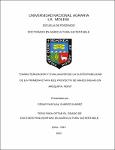Mostrar el registro sencillo del ítem
Caracterización y evaluación de la sustentabilidad de la primera etapa del proyecto de Majes-Siguas en Arequipa, Perú
| dc.contributor.advisor | Julca Otiniano, Alberto Marcial | |
| dc.contributor.author | Suárez Suárez, César Pascual | |
| dc.date.accessioned | 2023-05-08T17:14:26Z | |
| dc.date.available | 2023-05-08T17:14:26Z | |
| dc.date.issued | 2023 | |
| dc.identifier.uri | https://hdl.handle.net/20.500.12996/5783 | |
| dc.description | Universidad Nacional Agraria La Molina. Escuela de Posgrado. Doctorado en Agricultura Sustentable | es_PE |
| dc.description.abstract | El objetivo fue caracterizar y evaluar la sustentabilidad de las unidades agrícolas en la primera etapa del Proyecto Majes-Siguas en Arequipa, Perú. La población estuvo constituida por 2 673 productores, de la que se tomó una muestra (n=335) distribuidos en las 5 secciones del proyecto (A, B, C, D, E). Se usó una encuesta estructurada que recogió información de las tres dimensiones de la sustentabilidad, luego se seleccionaron sub-indicadores y se diseñaron fórmulas para calcular los indicadores de sustentabilidad económica, social, ambiental y el índice de sustentabilidad general. Se encontró que las características de los productores difieren entre una sección y otra, aunque mayoritariamente tienen más de 40 años de edad. El nivel de instrucción es mayormente primario y secundario, y las viviendas cuentan con algunos servicios básicos, mayormente solo luz. La mayoría son propietarios y piensan dejar el predio como herencia a sus hijos, no están organizados y tiene un mediano conocimiento y conciencia ecológica. Las principales características de las unidades agrícolas también difieren entre una sección y otra, la mayoría cultiva el 100 por ciento del área, hace agricultura + ganadería y rotación de cultivos. Emplean una mezcla de 60 por ciento abonos + 40 por ciento fertilizantes y el control de plagas es mayormente químico y hay una dependencia de insumos externos en un 40 por ciento. Todos usan riego tecnificado, la mayoría 50 por ciento por goteo + 50 por ciento por aspersión que no tienen acceso al crédito agrícola y los que tienen, son principalmente de la banca privada. La mayoría tiene una sola vía de comercialización y la rentabilidad de los cultivos está mayormente entre 11 al 20 por ciento y las crianzas entre 1 al 10 por ciento. Para evaluar la sustentabilidad, se usó el “Marco SAFE” y la fórmula adaptada del “Análisis Multicriterio”. La mayor parte de las unidades agrícolas son sustentables socialmente, ambientalmente y económicamente. De manera general, la mayoría fueron sustentables, especialmente en la sección C. | es_PE |
| dc.description.abstract | The objective was to characterize and evaluate the sustainability of the agricultural units in the first stage of the Majes-Siguas Project in Arequipa, Peru. The population consisted of 2 673 producers, from which a sample was taken (n=335) distributed in the 5 sections of the project (A, B, C, D, E). A structured survey was used that collected information on the three dimensions of sustainability, then sub-indicators were selected and formulas were designed to calculate the indicators of economic, social, environmental sustainability and the general sustainability index. It was found that the characteristics of the producers differ from one section to another, although most of them are over 40 years old. The level of instruction is mostly primary and secondary, and the houses have some basic services, mostly just electricity. Most of them are owners and plan to leave the property as an inheritance to their children, they are not organized and have a moderate knowledge and ecological awareness. The main characteristics of the agricultural units also differ from one section to another, most cultivate 100 percent of the area, do agriculture + livestock and crop rotation. They use a mixture of 60 percent fertilizers + 40 percent fertilizers and pest control is mostly chemical and there is a 40 percent dependence on external inputs. All use technified irrigation, most 50 percent drip + 50 percent sprinkler who do not have access to agricultural credit and those who do, are mainly from private banks. Most have a single marketing channel and the profitability of crops is mostly between 11 to 20 percent and breeding between 1 to 10 percent. To assess sustainability, the "SAFE Framework" and the adapted formula of the "multi-Criteria Analysis" were used. Most of the agricultural units are socially, environmentally and economically sustainable. In general, most were sustainable, especially in section C. | es_PE |
| dc.format | application/pdf | es_PE |
| dc.language.iso | spa | es_PE |
| dc.publisher | Universidad Nacional Agraria La Molina | es_PE |
| dc.rights | info:eu-repo/semantics/openAccess | es_PE |
| dc.rights.uri | https://creativecommons.org/licenses/by-nc-nd/4.0/ | es_PE |
| dc.subject | Indicadores de sustentabilidad | es_PE |
| dc.title | Caracterización y evaluación de la sustentabilidad de la primera etapa del proyecto de Majes-Siguas en Arequipa, Perú | es_PE |
| dc.type | info:eu-repo/semantics/doctoralThesis | es_PE |
| thesis.degree.discipline | Agricultura Sustentable | es_PE |
| thesis.degree.grantor | Universidad Nacional Agraria La Molina. Escuela de Posgrado | es_PE |
| thesis.degree.name | Doctoris Philosophiae - Agricultura Sustentable | es_PE |
| dc.subject.ocde | https://purl.org/pe-repo/ocde/ford#4.01.01 | es_PE |
| renati.author.dni | 29301745 | es_PE |
| dc.publisher.country | PE | es_PE |
| dc.type.version | info:eu-repo/semantics/publishedVersion | es_PE |
| renati.advisor.orcid | https://orcid.org/0000-0002-3433-9032 | es_PE |
| renati.advisor.dni | 08351817 | es_PE |
| renati.type | https://purl.org/pe-repo/renati/type#tesis | es_PE |
| renati.level | https://purl.org/pe-repo/renati/level#doctor | es_PE |
| renati.discipline | 811018 | es_PE |
| renati.juror | Jiménez Dávalos, Jorge Eduardo | |
| renati.juror | Loli Figueroa, Oscar Oswaldo | |
| renati.juror | Heros Aguilar, Elizabeth Consuelo | |
| renati.juror | Anculle Arenas, Lázaro Alberto |
Ficheros en el ítem
Este ítem aparece en la(s) siguiente(s) colección(ones)
-
D-ASUS Tesis [73]





